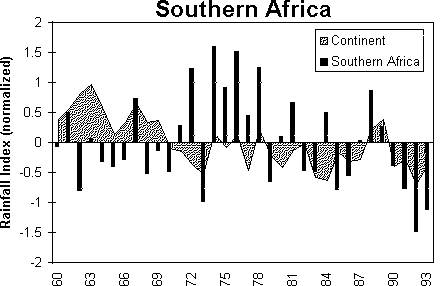|
|
 |
|
|
|
 |
| |
|
|
 |
Food & Climate
Read more |
The present realities and the future uncertainties
Even with many uncertainties, the climate change issue has emerged as the major environmental of our time: we are coming to recognize that current and future levels of energy use from burning of fossil fuels and clearing of forests for cultivation can have profound effects on the global environment, and on key economic sectors in the coming century. Global warming presents a challenge to understand what is at stake and to manage future development wisely.
|
|
|
|
|
 |
 |
 |
|
1. People in Africa
|
|
 |
The economic consequences arising from disastrous climatic events are today part of all media. The familiar images of famine caused by drought or torrential rains, the amounts of money spent in international relief efforts to prevent widespread famine, are a concern to all. |
|
Almost all realize that food production is linked to weather and climate. In 1987 weak monsoon rains in India and Pakistan, were responsible for low crop yields and forced these countries to revert to wheat importation. The 1980s also saw the continuing deterioration of food production in Africa, caused in part by persistent drought and low production potential. The 1991-92 drought in southern Africa is generally regarded as the worst of the century, affecting nearly 100 million people living in the 10 SADAC (Southern African Development Community) estates; 11.6 million tons of drought related commodities had to be imported within a 13 month period. It is also clear the future water availability at any cost or for any use is questionable.
|
 |
 |
|
2. This graph shows the variation of precipitation for South Africa. There was a great decrease between 90 and 92
From Sustainable Development Department, FAO
|
|
If the build-up of CO2 and other greenhouse gases in the atmosphere continues without limit, it is bound, sooner or later, to warm the earth’s surface. Such a warming trend cannot but affect water supply, agriculture, and food production. At its heart, the climate change debate shares the defining characteristic of all other debates about simulating the future: it is dominated by uncertainties.
But all the scientists point out that although models are full of uncertainties, the effects of climate change are not unpredictable. The uncertainties argue in favour of further research. If CO2 emissions are not curtailed, knowing the benefits and disadvantages of alternative responses to global warming is crucial, even if they are far from perfect.
|
Predicting the future arises great uncertainties:
• What will be the future levels of carbon dioxide?
• How much warming will occur, when and at what rate, and according to what geographical and seasonal pattern?
• What will be the consequences to agricultural productivity in different countries and regions?
• Will some areas benefit while other areas suffer, and who might the winners and losers be?
• What can be done to mitigate these changes?
• What can be done to adapt our practices so as to minimize or even overcome them?
|
Author: Marta Moneo and Ana Iglesias- Universidad Politécnica de Madrid - España
1. Scientific reviewer: Alex de Sherbinin - CIESIN, Columbia University - USA
2. Scientific reviewer: Lily Parshall - Goddard Institute for space studies, Columbia University - USA
Educational reviewer: Emilio Sternfeld - Colegio Virgen de Mirasierra - España
Last update: 12/05/2004 |
|
 |
|









